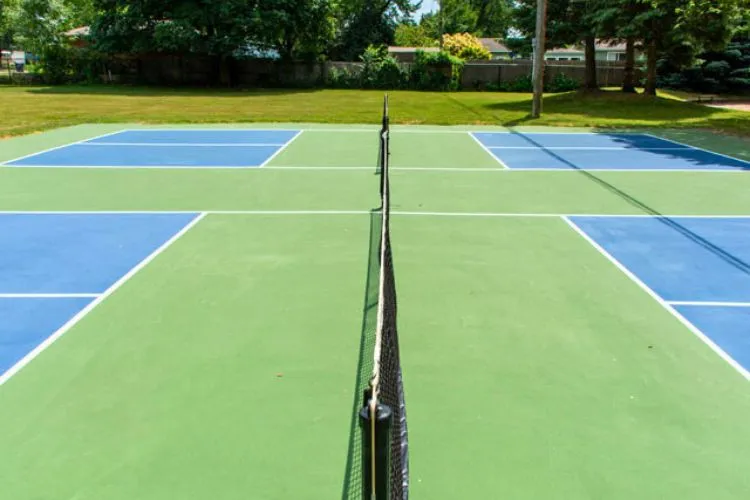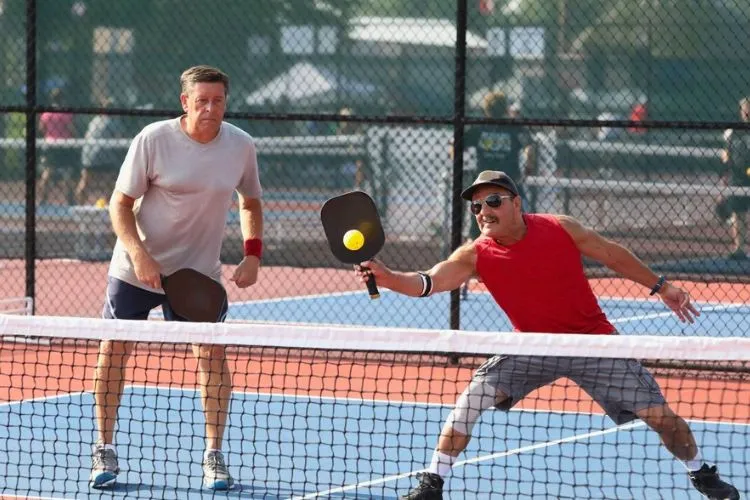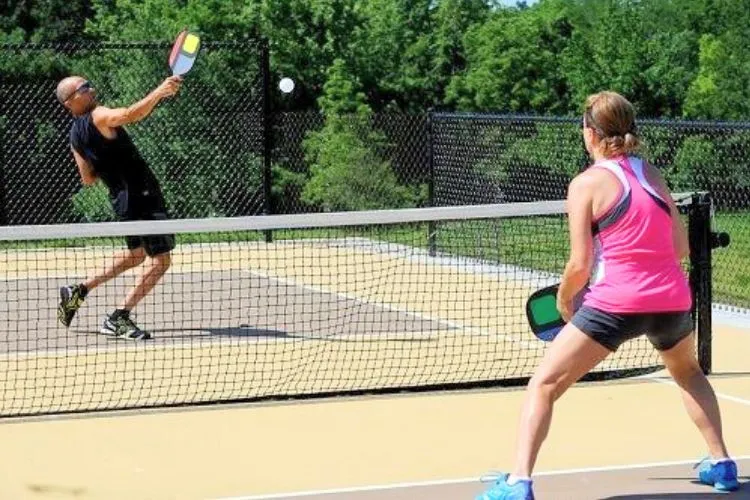When it comes to pickleball, understanding the dimensions of the court is crucial to mastering the game.
The kitchen, also known as the non-volley zone, plays a significant role in gameplay and strategy.
In this comprehensive guide, we will explore how big is the kitchen in pickleball and its impact on your performance.

From court measurements to essential strategies, you will gain the knowledge needed to excel on the pickleball court.
How big is the kitchen in pickleball (Non-Volley Zone)?
The kitchen, also referred to as the non-volley zone, is an area on the pickleball court that has its own set of rules.
It extends 7 feet from either side of the net, creating a 14-foot zone where players cannot hit the ball out of the air (volley), except under specific circumstances.
Understanding Kitchen Measurements
The kitchen area measures 7 feet by 20 feet. Its size is carefully designed to create a strategic playing zone. The kitchen’s proximity to the net allows for quick reactions, agile footwork, and precise shot placement.
Court Split
To further optimize gameplay dynamics, the pickleball court can be divided into smaller playing areas.
By splitting the court into 20 x 15-foot sections, teams can strategically position themselves within their assigned zones. This division impacts team dynamics and can influence gameplay strategies.
Strategy and Gameplay Tips within the Kitchen

Mastering Footwork and Positioning
Within the kitchen, mastering footwork and positioning is crucial. By staying close to the net, players can react swiftly to their opponent’s shots and maintain control over the game.
The goal is to be on the balls of your feet, ready to move in any direction to intercept the ball and maintain a dominant position.
Shot Selection and Placement
The kitchen’s small size provides an opportunity to strategically place shots in areas that exploit opponents’ vulnerabilities.
Focus on executing well-placed dink shots, aiming for areas where opponents struggle to reach. By doing so, you can create advantageous situations that lead to scoring points.
Communication and Teamwork
Effectively communicating and coordinating with your partner is key to success in the kitchen. Establish clear signals or calls to indicate who will take specific shots.
Efficient teamwork will prevent confusion and reduce unforced errors, giving you an edge over your opponents.
Volleying Smartly within the Kitchen
Volleying, or hitting the ball out of the air before it bounces, is a crucial skill in pickleball. However, within the kitchen, players are prohibited from volleying unless the ball bounces first or if they are outside the non-volley zone.

So how can you still utilize volleying effectively within the kitchen? Let’s explore some smart strategies.
Utilize a Soft Volley Approach
While you cannot execute aggressive volleys from within the kitchen, you can still use soft volleys to keep the ball in play. Soft volleys, also known as dinks, are gentle shots that arc over the net and land close to your opponent’s feet.
By using soft volleys strategically, you can disrupt your opponent’s rhythm, force them into defensive positions, and set up opportunities for winning shots.
Aim for Angles and Placement
When volleying within the kitchen, it’s essential to focus on angles and precision placement. Instead of aiming for power, try to direct your volleys to the corners of the court or spots that are difficult for your opponent to reach.
By hitting the ball with accuracy and finesse, you can create openings and put pressure on your opponents to make difficult returns.
Master the Drop Volley
The drop volley is a versatile shot that can be effective within the kitchen. It involves softly dropping the ball just over the net and close to the kitchen line.
The objective is to force your opponent to move forward quickly, putting them at a disadvantage. By practicing the drop volley technique, you can surprise your opponents and gain control of the point.
Combine Volleys with Dinks
A smart approach within the kitchen is to seamlessly transition between volleys and dinks. This strategy helps you keep your opponents guessing and makes it challenging for them to anticipate your next move.
By varying your shot selection, you can create confusion and exploit gaps in your opponent’s defenses.
Remember, the key to successful volleying within the kitchen is to maintain control and finesse. Avoid going for aggressive shots that may result in errors or hitting the ball out of bounds.
By deploying smart volleying techniques, you can keep the ball in play, maintain pressure on your opponents, and create scoring opportunities.
Stay Ahead with Court Awareness
In addition to mastering footwork, shot selection, and volleying within the kitchen, developing court awareness is crucial for success in pickleball.

Court awareness involves understanding your position on the court, anticipating your opponent’s movements, and adjusting your gameplay accordingly.
Monitor Your Positioning
Always be aware of your position on the pickleball court, especially within the kitchen. Consistently strive to remain on the balls of your feet, with your weight forward and ready to move quickly. By staying in an optimal position, you can react swiftly to shots and maintain control during rallies.
Anticipate Your Opponent’s Shots
Pay close attention to your opponent’s shot selection patterns and tendencies. Try to predict where they might hit the ball and prepare yourself to move accordingly.
By anticipating their shots, you can position yourself strategically and potentially intercept or counter their shots effectively.
Communicate with Your Partner
Communication with your partner is vital in pickleball, and having good court awareness strengthens this aspect of gameplay. Keep each other informed about your movements and intentions and strategize together.
By maintaining open lines of communication, you can coordinate your movements, cover each other effectively, and minimize miscommunication errors.
Be Mindful of Court Boundaries
It is crucial to be aware of the boundaries of the pickleball court, especially within the kitchen. Stay mindful of your position in relation to the kitchen lines to avoid faults and adhere to the rules.
By being aware of the boundaries, you can maintain fair gameplay and prevent unnecessary errors. Court awareness is a skill that develops over time with practice and experience.
By honing your court awareness skills, you can become more proactive, react faster to your opponent’s shots, and make more strategic and calculated decisions on the pickleball court. Stay focused, stay alert, and stay one step ahead of your opponents.
Frequently Asked Questions (FAQs)
How far is the kitchen line from the net in pickleball?
The kitchen line is 7 feet away from the net on either side, creating a 14-foot non-volley zone along the width of the court. It is essential to stay behind this line to abide by the non-volley rule, ensuring fair gameplay.
What are the rules and regulations governing the kitchen in pickleball?
The kitchen has specific rules to prevent players from gaining an unfair advantage. In general, players cannot hit the ball out of the air while inside the kitchen, except under certain circumstances. Familiarize yourself with the kitchen rules for a fair and enjoyable game.
Are there any specific strategies for playing in the kitchen area?
Yes, there are specific strategies for playing in the kitchen area. Mastering footwork and positioning, along with precise shot selection and placement, are key elements to focus on. Additionally, effective communication and teamwork with your partner will enhance your performance within the kitchen.
How does the kitchen impact gameplay dynamics?
The kitchen significantly impacts gameplay dynamics as it discourages players from attempting volleys close to the net. This rule promotes strategic gameplay, requiring players to rely on precise shots and finesse rather than brute strength. It creates a challenging and exciting environment for players to test their skills.
Conclusion:
The size of the kitchen in pickleball is an essential aspect of the game. Understanding its dimensions and the rules associated with it helps you develop effective strategies.
By mastering footwork, shot placement, and teamwork within the kitchen, you can gain a competitive edge.
So, remember to stay behind the kitchen lines, communicate effectively, and use the compact playing area to your advantage. With this knowledge, you’ll be able to navigate the pickleball court with confidence and finesse.

Pickleball’s more than a game to me—it’s a passion. I write, sharing its highs and lows, the thrills and the lessons. Some tales might draw you to the court, while others give a hint of the game’s magic. So, curious about my journey? Ready to dive deep into the world of pickleball with me? Let’s go.
